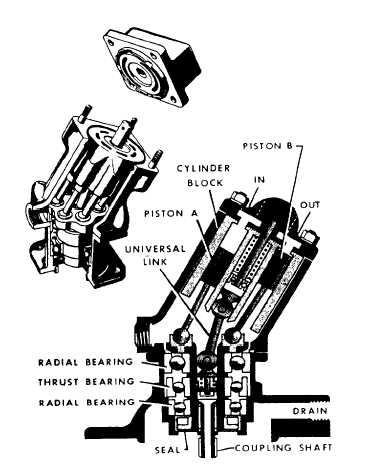Reciprocating Pumps
Reciprocating pumps are most commonly used for applications requiring high pressures and accurate control of the discharge volume. There are many variations of this pump, which is normally refereed to as a piston pump in support equipment; however, they are generally based on the axial piston or hand pump principle. There are also radial piston pumps, but they are hardly ever used in design of support equipment systems.
It is not within the scope of this TRAMAN to cover all the variations of the piston pump since there are more than 20 manufacturers of these pumps; each has its own patented improvements to achieve efficiency and reduce wear. You should consult the appropriate technical manual for specific pump maintenance and repair information.
AXIAL-PISTON PUMPS. - Axial-piston pumps are classified as either constant volume or variable volume. The paragraphs below explain the overall operation of the pump and the means designed into the variable volume pump to provide stroke reduction.
Constant Volume Piston Pump. - The constant volume piston pump (fig. 10-8) produces a constant flow of fluid for any given rpm. The pistons, usually about nine (always an odd number), are fastened by a universal linkage to a drive shaft. The universal link in the center drives the cylinder block; it is held at an angle to the drive shaft by the pump housing. Everything within the pump housing rotates with the drive shaft. As the piston is rotated to the upper position, its movement forces fluid out of the pressure port. As the same piston moves from the upper position to the lower position, it draws in fluid through the intake port. Since each piston is always somewhere between the upper and lower position, constant intake and output of fluid results. The volume output of the pump is determined by the angle between the drive shaft and the cylinder block, as the degree of angle decreases or increases the piston stroke. The larger the angle, the greater the output per revolution.
If you follow one piston through one complete revolution, you can see how the pump operates. Start with the piston at the top of its cylinder (fig. 10-8). It has just completed its pressure stroke and is ready to begin its intake stroke. As the cylinder starts its rotation from this point, the piston immediately aligns with the intake port as it moves toward the bottom of the cylinder. The partial vacuum created by the movement of the piston in the cylinder and the gravity pressure (in some cases, boost pressure) on the fluid cause the space above the piston to fill with fluid. When the cylinder has gone through 180 degrees or one-half revolution, the piston reaches the bottom of the cylinder; the cylinder is now full of fluid.
As rotation continues beyond this point, the piston now aligns with the outlet port slot. Thus, when the last 180 degrees have been completed, the piston will have moved forward in the cylinder; the fluid will have been forced into the outlet line. At this point, the piston and cylinder are again ready to start another cycle. There are several pistons performing the same function just described. Since the pump rotates rapidly, there is a constant flow of fluid through the outlet port.
This pump normally uses case pressure and fluid flow for cooling and lubricating. Fluid seeps by the pistons in the cylinder block and fills all the space inside the pump. The fluid is prevented from escaping through the drive end of the pump by a drive shaft seal. Excessive case pressure is prevented by routing the fluid back to the inlet port of the pump through one or more relief

Figure 10-8.-Example of a constant volume piston pump.
Continue Reading